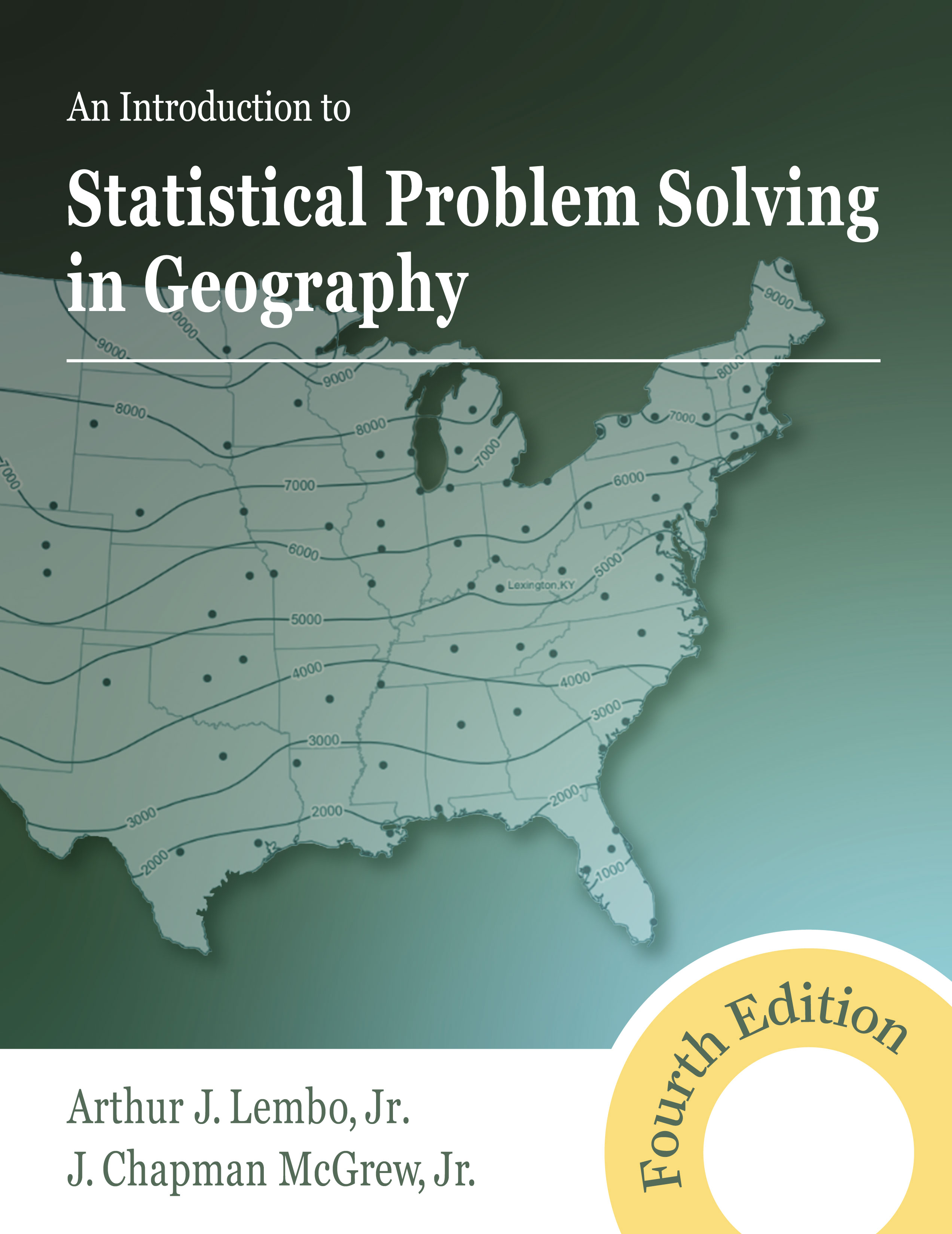"Excellent revision and additions! It is one of my favorite textbooks for students, clearly presenting the geographical perspective on solving quantitative problems." -Sheryl Luzzadder-Beach, University of Texas at Austin
"The reasonable cost is just icing on the cake of its other qualities. It is written at just the right level for undergraduate geography majors. The data examples are excellent. Every geography student finds some dataset that connects with their interests. The graphics are well drawn and produced." -Charles Geiger, Millersville University

354 pages, $59.95 list
1-4786-4946-1
978-1-4786-4946-5
© 2024
paperback
Student resource materials available here.
Instructor's resource materials available here
To obtain a username and password to access these materials, contact comps@waveland.com.
Instructor's resource materials available here
To obtain a username and password to access these materials, contact comps@waveland.com.
eBook availability
An Introduction to Statistical Problem Solving in Geography
Fourth Edition
The fourth edition of An Introduction to Statistical Problem Solving in Geography continues its standing as the definitive introduction to statistics and quantitative analysis in geography. Assuming no reader background in statistics, the authors lay out the proper role of statistical analysis and methods in human and physical geography. They delve into the calculation of descriptive summaries and graphics to explain geographic patterns and use inferential statistics (parametric and nonparametric) to test for differences (t-tests, ANOVA), relationships (regression and correlation), and spatial statistics (point and area patterns, spatial autocorrelation).
This edition introduces more advanced topics, including logistic regression, two-factor ANOVA, and spatial estimation (inverse distance weighting, Kriging). Many chapters also include thought-provoking discussions of statistical concepts as they relate to the COVID-19 pandemic. Maintaining an exploratory and investigative approach throughout, the authors provide readers with real-world geographic issues and more than 50 map examples. Concepts are explained clearly and narratively without oversimplification. Each chapter concludes with a list of major goals and objectives. An epilogue offers over 150 open-ended geographic situations, inviting students to apply their new statistical skills to solve problems currently affecting our world.
This edition introduces more advanced topics, including logistic regression, two-factor ANOVA, and spatial estimation (inverse distance weighting, Kriging). Many chapters also include thought-provoking discussions of statistical concepts as they relate to the COVID-19 pandemic. Maintaining an exploratory and investigative approach throughout, the authors provide readers with real-world geographic issues and more than 50 map examples. Concepts are explained clearly and narratively without oversimplification. Each chapter concludes with a list of major goals and objectives. An epilogue offers over 150 open-ended geographic situations, inviting students to apply their new statistical skills to solve problems currently affecting our world.
Reactions
Part 1: BASIC STATISTICAL CONCEPTS IN GEOGRAPHY
1. Introduction: The Context of Statistical Techniques
2. Geographic Data: Characteristics and Preparation
Part 2: DESCRIPTIVE PROBLEM SOLVING IN GEOGRAPHY
3. Descriptive Statistics and Graphics
4. Descriptive Spatial Statistics
Part 3: THE TRANSITION TO INFERENTIAL PROBLEM SOLVING
5. Basics of Probability and Discrete Probability Distributions
6. Continuous Probability Distributions and Probability Mapping
7. Basic Elements of Sampling
8. Estimation in Sampling
Part 4: INFERENTIAL PROBLEM SOLVING IN GEOGRAPHY
9. Elements of Inferential Statistics
10. Two-Sample and Dependent-Sample (Matched-Pairs) Difference Tests
11. Three-or-More-Sample Difference Tests: Analysis of Variance Methods
12. Categorical Difference Tests
Part 5: INFERENTIAL SPATIAL STATISTICS
13. General Issues in Inferential Spatial Statistics
14. Point Pattern Analysis
15. Area Pattern Analysis
Part 6: STATISTICAL RELATIONSHIPS BETWEEN VARIABLES
16. Correlation
17. Simple Linear Regression
Part 7: MULTIVARIATE PROBLEM-SOLVING IN GEOGRAPHY
18. Examples of Multivariate Problem-Solving in Geography
19. Multifactor Analysis: Two-Way Analysis of Variance
20. The Basics of Binary Logistic Regression
21. Estimation with Spatial Data
Part 8: EPILOGUE
22. Problem Solving and Policy Determination in Practical Geographic Situations
Appendix: Statistical Tables
1. Introduction: The Context of Statistical Techniques
2. Geographic Data: Characteristics and Preparation
Part 2: DESCRIPTIVE PROBLEM SOLVING IN GEOGRAPHY
3. Descriptive Statistics and Graphics
4. Descriptive Spatial Statistics
Part 3: THE TRANSITION TO INFERENTIAL PROBLEM SOLVING
5. Basics of Probability and Discrete Probability Distributions
6. Continuous Probability Distributions and Probability Mapping
7. Basic Elements of Sampling
8. Estimation in Sampling
Part 4: INFERENTIAL PROBLEM SOLVING IN GEOGRAPHY
9. Elements of Inferential Statistics
10. Two-Sample and Dependent-Sample (Matched-Pairs) Difference Tests
11. Three-or-More-Sample Difference Tests: Analysis of Variance Methods
12. Categorical Difference Tests
Part 5: INFERENTIAL SPATIAL STATISTICS
13. General Issues in Inferential Spatial Statistics
14. Point Pattern Analysis
15. Area Pattern Analysis
Part 6: STATISTICAL RELATIONSHIPS BETWEEN VARIABLES
16. Correlation
17. Simple Linear Regression
Part 7: MULTIVARIATE PROBLEM-SOLVING IN GEOGRAPHY
18. Examples of Multivariate Problem-Solving in Geography
19. Multifactor Analysis: Two-Way Analysis of Variance
20. The Basics of Binary Logistic Regression
21. Estimation with Spatial Data
Part 8: EPILOGUE
22. Problem Solving and Policy Determination in Practical Geographic Situations
Appendix: Statistical Tables